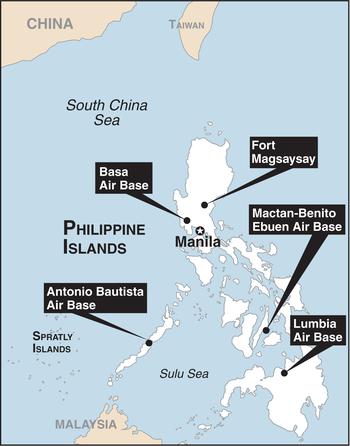Protesters display placards and burn a mock US flag to protest the visit of US Defense Secretary Lloyd Austin to the Philippines Thursday, Feb. 2, 2023, at Camp Aguinaldo in suburban Quezon city northeast of the capital Manila. (Bullit Marquez/for Stars and Stripes)
Fear of China and a change in administration in Manila have led to the agreement to expand the U.S. military presence in the Philippines — unthinkable decades ago but with major strategic implications.
The agreement, announced Thursday during a visit to Manila by Defense Secretary Lloyd Austin, allows the United States to store military equipment at nine locations in the former American colony, paving the way for the largest U.S. military presence in decades.
The Philippine Constitution bans permanent foreign military bases in the Philippines, and Austin made clear the new sites were not permanent. Philippine officials granted the U.S. limited access to five bases in 2016 and in the latest agreement have agreed to add four more, although they have not identified them publicly.
It is assumed the U.S. would like access to installations on Palawan Island, which faces the South China Sea, and in northern Luzon, the largest of the 7,100 Philippine Islands located south of Taiwan, which China considers a renegade province and has vowed to reclaim, if necessary, by force.
The Associated Press reported that China’s Foreign Ministry spokeswoman Mao Ning accused the U.S. of pursuing “its selfish agenda” with the new arrangement with the Philippines.
“The U.S. has adhered to a Cold War zero-sum mentality and strengthened military deployment in the region,” the AP quoted Mao as telling reporters at a daily briefing. “This is an act that escalates tensions in the region and endangers regional peace and stability.”

(Noga Ami-rav/Stars and Stripes)
The deal represents a strategic setback for China, which blew an opportunity to wean Manila away from Washington amid the storm over an alleged Chinese spy balloon violating American airspace.
Thirty years ago, such an agreement between Washington and Manila would have been unthinkable. For generations millions of Filipinos opposed the U.S. military presence in their country as a vestige of American colonialism that began in 1898 when the U.S. seized the islands from Spain in the Spanish-American War.
After ending more than 300 years of Spanish rule, the U.S. crushed a Filipino independence movement in a brutal, three-year war that claimed up to 1 million lives and put down a separate uprising by Muslims in the south that dragged on until 1913.
Although the Philippines gained full independence in 1946 after World War II, Filipino nationalists and leftists demanded the Americans leave Clark Air Base and the Subic Bay naval station, two of the largest U.S. military bases overseas that formed a linchpin of American military power in East Asia.
That sentiment reached a high point during the opposition movement that ousted the late dictator Ferdinand Marcos in the 1986 “People Power” revolution that propelled Corazon Aquino into the presidency.
In 1992 the Philippine Senate rejected an agreement to extend the lease on the Subic Bay base, the last American installation in the country. The U.S. already had agreed to give up Clark Air Base after it was heavily damaged in the 1991 eruption of the Mount Pinatubo volcano.
Seven years after Subic closed, the U.S. and Philippines negotiated a Visiting Forces Agreement, allowing for joint training exercises and a limited, rotational American presence.
The U.S. also sent about 250 special operators to the southern Philippines to assist Philippine troops fighting Islamic extremists in the Sulu islands and Mindanao, the second-largest Philippine island.
China’s military moves in the South China Sea brought renewed attention to the strategic value of the Philippines. Both the U.S. and the Philippines strongly opposed China’s placing military equipment on a chain of artificial islands it had built in the South China Sea, including waters claimed by Manila and other Southeast Asian countries.
Diplomatic moves suffered a setback when populist Philippine President Rodrigo Duterte took office in 2016. Duterte began to distance himself from Washington to try to cultivate closer ties with China and to punish Washington for its criticism of his human rights record, including sanctioning police killing of suspected drug dealers.
Duterte announced he was canceling the military agreements with Washington and on his first trip to Beijing declared it was “time to say goodbye to Washington.”
However, all that cozying up to Beijing produced few results.
Duterte failed to nail down deals for China to fund Philippine infrastructure projects. Nor did they dissuade China from pursuing the militarization of the South China Sea.
In 2019 Chinese militia boats encircled an island claimed by the Philippines to prevent authorities from upgrading the island’s runway. A few months later China moored 200 fishing boats at a reef claimed by the Philippines.
With his policy in shambles, Duterte reversed his decision to cancel the agreement with Washington under pressure from his own Cabinet. His successor, Ferdinand “Bongbong” Marcos Jr., son of the ousted dictator, has accelerated moves toward the U.S. after taking office in June.